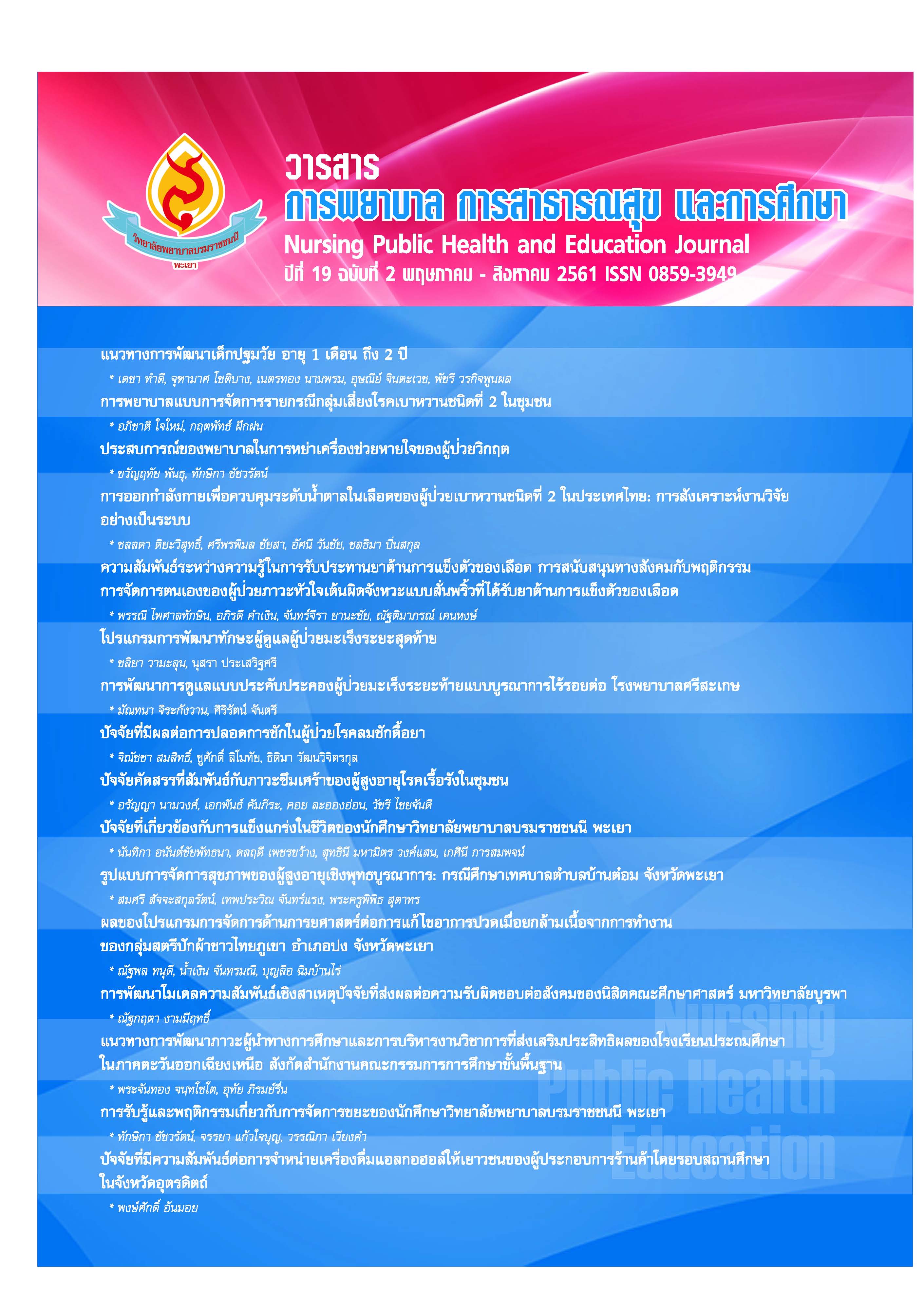แนวทางการออกกำลังกายเพื่อควบคุมระดับน้ำตาลในเลือดของผู้ป่วยเบาหวานไทย : การสังเคราะห์งานวิจัยอย่างเป็นระบบ
คำสำคัญ:
การสังเคราะห์อย่างเป็นระบบ, ผู้ป่วยเบาหวานชนิดที่2, การออกกำลังกายระดับน้ำตาลในเลือด, Systematic Review, Patient with type 2diabetes, Exercise, Blood sugar levelบทคัดย่อ
การออกกำลังกายเป็นแนวทางที่สามารถช่วยให้ผู้ป่วยเบาหวานควบคุมระดับน้ำตาลในเลือดได้ อย่างไร ก็ตาม ยังไม่มีการวิเคราะห์งานวิจัยอย่างเป็นระบบว่าวิธีการออกกำลังกายชนิดใดที่เหมาะสมกับผู้ป่วยเบาหวานไทยการทบทวนงานวิจัยอย่างเป็นระบบครั้งนี้มีวัตถุประสงค์เพื่อสังเคราะห์งานวิจัยเกี่ยวกับการออกกำลังกายเพื่อควบคุมระดับน้ำตาลในเลือดของผู้ป่วยเบาหวานชนิดที่ 2 ในประเทศไทย กลุ่มตัวอย่างคืองานวิจัยกึ่งทดลองหรือทดลองแบบ 2 กลุ่มที่ตีพิมพ์ในวารสารทั้งภาษาไทยและภาษาอังกฤษ สืบค้นข้อมูลในฐานข้อมูลอิเล็คโทรนิกส์ ได้แก่ ThaiLis, ThaiJo, CINHAL และ Google scholar ตั้งแต่ปี พ.ศ.2550 ถึง พ.ศ.2560 วิเคราะห์ข้อมูลโดยการสรุปเชิงเนื้อหา ผลการวิจัยพบว่ามีงานวิจัยที่ผ่านเกณฑ์การคัดกรอง จำนวน 5เรื่องจาก 31 เรื่อง มีจำนวนผู้ป่วยทั้งสิ้น 274 คนสรุปการออกกำลังกายที่สามารถควบคุมระดับน้ำตาลในเลือดของผู้ป่วยเบาหวานชนิดที่ 2 ในประเทศไทย ได้ 2 ชนิดคือ 1) การออกกำลังกายแบบแอโรบิกแบบหนักปานกลาง และ 2) การออกกำลังกายแบบยืดเหยียดกล้ามเนื้อ จากผลการวิจัยชี้ให้เห็นประโยชน์ของการออกกำลังกายทั้ง 2 รูปแบบในผู้ป่วยเบาหวานชนิดที่ 2 ในประเทศไทย ดังนั้นจึงมีข้อเสนอแนะว่าบุคลากรทางสุขภาพควรแนะนำและส่งเสริมให้ผู้ป่วยเบาหวานชนิดที่ 2 ในประเทศไทยออกกำลังกายแบบสองรูปแบบนี้เพื่อให้ผู้ป่วยสามารถควบคุมระดับน้ำตาลในเลือดได้
Exercise to control blood sugar levels of Patients with type 2diabetes in Thailand: A Systematic Review
Exercise is one way to help patients with diabetes to control blood sugar levels. However, there is no systematic review to find out what types of exercise suitable for patients with diabetes in Thailand.The purpose of this systematic review was to synthesize previous studies related to exercise to control blood sugar levels among Thai patients with type 2diabetes mellitus. Sample were published articles written in Thai and English from 2007 to 2017 searched from electronic databases, including ThaiLis, ThaiJo, CINHAL, and Google scholar. The content analysis was used to analyze data. The results showed that of the 31 searched papers, 5 papers met the inclusion criteria. Total of 274 patients were included. Exercise types that could control blood sugar levels of Thai patients with type 2diabetes were 1) aerobic exercise with moderate intensity and 2) stretching exercise. The results of the study indicated the benefits of both types of exercises for Thai patients withtype 2 diabetes. Therefore, health care providers should suggest and promote Thai patients with type 2diabetes to do these types of exercise so that they can control their blood sugar levels.
เอกสารอ้างอิง
ขวัญหทัย ไตรพืช, และคณะ. (2553). การสังเคราะห์งานวิจัยเกี่ยวกับการออกกำลังกายที่มีผลต่อการควบคุมระดับ
น้ำตาลในเลือดในผู้ที่เป็นเบาหวานชนิดที่ 2. รามาธิบดีพยาบาลสาร,16(2), 259-278.
เนติมา คูนีย์. (2555). แนวทางเวชปฏิบัติการออกกำลังกายในผู้ป่วยเบาหวานและความดันโลหิตสูง.
นนทบุรี: โรงพิมพ์องค์การสงเคราะห์ทหารผ่านศึกในพระบรมราชูปถัมภ์.
นุชรี อาบสุวรรณ และนิตยา พันธุเวทย์. (2555). ประเด็นรณรงค์วันเบาหวานโลก ปี 2554
(ปีงบประมาณ 2555). สืบค้นเมื่อวันที่ 5 มกราคม 2561, จาก http://www.thaincd.com/document/doc/general/DM-2554.pdf
บำเหน็จ แสงรัตน์,โรจนี จินตนาวัฒน์, และกนกพร สุคำวัง. (2552). ผลของการออกกำลังกายแบบฟ้อนเจิง.
ต่อระดับไกลโคไซเลทฮีโมโกลบินของผู้สูงอายุโรคเบาหวานชนิดที่ 2. พยาบาลสาร,36 (4),59-72.
ยุพิน ภูวงษ์ และสมเดช พินิจสุนทร. (2557). ภาวะแทรกซ้อนที่เกิดจากโรคเบาหวานของผู้ป่วยที่ขึ้น
ทะเบียนรักษาในโรงพยาบาลชุมชนคัดสรรในภาคตะวันออกเฉียงเหนือ. วารสารการพัฒนา
สุขภาพชุมชน มหาวิทยาลัยขอนแก่น, 2(3): 311-319.
เยี่ยม คงเรืองราช, ทวีลักษณ์ วรรณฤทธิ์, และนาดา ลัคนหทัย. (2555). ผลของการออกกำลังกาย
แบบฟ้อนหมอลำกลอน ต่อระดับฮีโมโกลบินเอวันซี ในผู้ที่เป็นเบาหวานชนิดที่ 2.
พยาบาลสาร, 39(3),105-116.
สมาคมโรคเบาหวานแห่งประเทศไทย ในพระราชูปถัมภ์สมเด็จพระเทพรัตนราชสุดาฯ สยามบรมราชกุมารี,
สมาคมต่อมไร้ท่อแห่งประเทศไทย, กรมการแพทย์ กระทรวงสาธารณสุข,และสำนักงานหลักประกัน
สุขภาพแห่งชาติ. (2560). แนวทางเวชปฏิบัติสำหรับโรคเบาหวาน 2560. ปทุมธานี: บริษัท ร่มเย็น มีเดีย
จำกัด.
สำนักนโยบายและยุทธศาสตร์ สำนักงานปลัดกระทรวงสาธารณสุข. (2558). จำนวนและอัตราตาย
ด้วยโรคเบาหวาน (E10-E14) ต่อประชากร 100,000 คน ปี พ.ศ.2550 - 2557 จำแนกราย
จังหวัด สคร.เขต และภาพรวมประเทศ (รวมกรุงเทพมหานคร). สืบค้นเมื่อวันที่ 5 มกราคม
2561, จาก http://thaincd.com/information-statistic/non-communicable-disease-data.php
สำนักโรคไม่ติดต่อ กรมควบคุมโรค กระทรวงสาธารณสุข. (2557). จำนวนและอัตราผู้ป่วย
เบาหวานรายใหม่ต่อประชากร 100,000 คน ปี พ.ศ. 2550 – 2557 จำแนกรายจังหวัด สคร.
เขต และภาพรวมประเทศ (รวมกรุงเทพมหานคร). สืบค้นเมื่อวันที่ 5 มกราคม 2561, จาก
http://thaincd.com/information-statistic/non-communicable-disease-data.php.
อัจฉรา แสนไชย, ลินจง โปธิบาล, และภารดี นานาศิลป์. (2554). ผลของการปฏิบัติสมาธิ
เคลื่อนไหวไทยชี่กงต่อระดับฮีโมโกลบินเอวันซีในผู้สูงอายุโรคเบาหวานชนิดที่ 2.
พยาบาลสาร,38(4),65-80.
อริสรา สุขวัจนี. (2557). ผลการออกกําลังกายเพื่อความยืดหยุ่นต่อระดับน้ำตาลในเลือดและ
ความสามารถในการปฏิบัติกิจวัตรประจำวันของผู้สูงอายุที่เป็นโรคเบาหวาน. วารสารไทย
เภสัชศาสตร์และวิทยาการสุขภาพ, 9(2),55-59.
American College of Sports Medicine. (2006). ACSM’s guidelines for exercise testing and
prescription. (7thed). Philadelphia: Lippincott Williams & Wilkins.
American Diabetes Association.(2017). Lifestyle Management.Diabetes Care, 40(Supplement 1):
S33-S43.
เอกสารอ้างอิง
Asif, M. (2014).The prevention and control the type-2 diabetes by changing lifestyle and dietary
pattern. Journal of Education and Health Promotion 3:1. Retrieved January 5, 2018, from :
https://www.ncbi.nlm.nih.gov/pmc/articles/PMC3977406/?report=reader
Colberg, S. R., Sigal, R. J., Fernhall, B., Regensteiner, J. G., Blissmer, B. J., Rubin, R. R., Taber,
L. C., Albright, A. L., & Braun, B. (2010). Exercise and type 2 diabetes: The American
College of Sports Medicine and the American Diabetes Association: joint position
statement. Diabetes Care, 33(12),e147–e167.
Hedge, S. V., Adhikari, P., Kotian, S., Pinto, V. J., D’Souza, S., & D’Souza, V. (2011).Effect of
3-month yoga on oxidative stress in type 2 diabetes with or without complications.
Diabetes Care, 11(1),1-3.
Higgins, J. P., & Green, S. (2011). Cochrane Handbook for Systematic Reviews of Interventions.
Retrieved January 5, 2018, from http://handbook.cochrane.org/v5.0.2/
International Diabetes Federation. (January 5, 2015). Diabetes Atlas, 7th Edition.Retrieved
January5, 2018, fromhttps://www.idf.org/e-library/epidemiology-research/diabetes-atlas/13-diabetes-atlas- seventh-edition.html
Meng, D., Chunyan, W., Xiaosheng, D., &Xiangren, Y. (2018). The effects of qigong on type 2
diabetes mellitus: A systematic review and meta-analysis. Evidence-Based Complementary
and Alternative Medicine, 8182938. Retrieved July4, 2018, from
http://doi.org/10.1155/2018/8182938
Moher, D., Liberati, A., Tetzlaff, J., Altman, D. G. (2009). Preferred reporting items for systematic
reviews and meta-analyses: The PRISMA statement. PLoS Med.Retrieved July 4, 2018,
from http://journals.plos.org/plosmedicine/article?id=10.1371/journal.pmed.1000097
Solomen, S., Shakya, R., & Aaron, P. (2015).Passive stretching versus active stretching on
immediate blood glucose in subjects with type II diabetes mellitus -A pilot study. International Journal of Physical Education, Sports, and Health, 2(1),146-149.
Sun, G. C., Lovejoy, G. C., Gillham, S., Putiri, A., Sasagawa, M., & Bradley, R. (2010).Effects of
qigong on glucose control in type 2 diabetes. Diabetes Care,33(1),e8.
Putiri, A. L., Close, J. R., Lilly, H. R., Guillaume, N., & Sun, G.-C. (2017). Qigong exercises for the
management of type 2 diabetes mellitus. Medicines, 4(3), 59.Retrieved July4, 2018,
from http://doi.org/10.3390/medicines4030059
Yardley, J. E., Kenny, G. P., Perkins, B. A., Riddell, M. C., Balaa, N., Malcolm, J., Boulay, P,
Khandwala, F., &Sigal, R. J. (2013).Resistance versus aerobic exercise: Acute effects
onglycemia in type 1 diabetes. Diabetes Care, 36(3), 537-542.
Youngwanichsetha, S., Phumdoung, S., & Ingkathawornwong, T. (2013).The effects of tai chi
gigong exercise on plasma glucose levels and health status of postpartum Thai women with type 2 diabetes. Focus on Alternative and Complementary Therapies, 18(4), 182-187.



